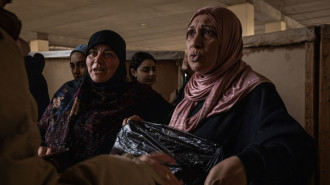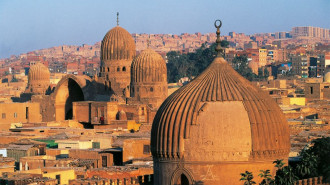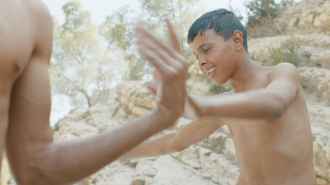![World Hijab Day animated graphic [Getty Images]](/sites/default/files/styles/image_360x240/public/2022-02/GettyImages-1363857473.jpg?h=119335f7&itok=jm2Ew-CK)
World Hijab Day: Why we need to talk about the headscarf
![World Hijab Day animated graphic [Getty Images]](/sites/default/files/styles/image_360x240/public/2022-02/GettyImages-1363857473.jpg?h=119335f7&itok=jm2Ew-CK)
Twenty years ago, a day dedicated to the hijab would have been unheard of. Without social media and pop culture to propel it into mainstream media, the headscarf was only seen as something your mum or aunty wore, a piece of cloth clumsily wrapped around our head to attend mosque or Arabic classes.
Now, with the phenomenal rise of hijab-wearing influencers and almost daily headlines debating the hijab’s place in society, it has somehow become the norm, at least here in the UK.
"For Muslim women, wearing the hijab embodies their faith and informs the way they move, speak and interact with others"
And while acceptance of the hijab should be celebrated, more needs to be done to acknowledge those who can’t exercise their freedom and free will to wear it.
Western Europe – I’m talking to you.
I was inclined to make this a positive piece, filled with funny anecdotes and quotes from women who feel empowered in their hijab, but that wouldn’t be an accurate reflection of wider society today. There are still countries where women are killed for choosing not to wear the hijab, governments who are banning women from wearing it and social media users who will send death threats if their favourite Muslim influencer dares to take it off.
So, this year, instead of celebrating World Hijab Day, I want to talk about the oppression women face for wanting to wear it (and also, those who don’t).
It’s 2022 and the Western world still want to police women’s bodies
Women in France are fighting to keep their headscarves on after President Macron’s controversial Separatism Bill was approved last year. If this Bill becomes law it will mean that French Muslim women under the age of 18 will be banned from wearing a hijab in public.
|
Sadly, the news didn’t come as a surprise for many Muslim women living in France who, from April 2011, were already banned from wearing the niqab. Since then, many other European countries such as the Netherlands, Austria, Denmark, Bulgaria, Germany, Italy and Spain have followed suit.
In light of the developments in France, hijabi fashion influencer Rawdah Mohammed, posted an image of herself with the words “hands off my hijab” on Instagram. In the caption, she spoke about her experience wearing a hijab as a child and being bullied. She writes, “I have never felt so stripped off my rights, I’ve never felt so belittled. They reduced me to nothing.”
The other side of the hijab
While women in the West are protesting to keep their headscarves on, there are those on the other side of the world fighting to take it off.
Women in Afghanistan’s capital Kabul have been protesting the Taliban’s strict laws on modesty.
"This World Hijab Day let's celebrate our freedom of choice, while remembering those women who don’t have the same privileges"
The Taliban, who returned to power last year, maintain that wearing the burqa is not mandatory but uphold the views that all women must cover their hair and body.
Wearing the hijab is also enforced by the law in Iran, where women are forced to cover up.
Then there are countries like Saudi Arabia, which, keen to shed their conservative image, have relaxed women’s dress code, yet the hijab remains mandatory.
For Muslim women, wearing the hijab embodies their faith and informs the way they move, speak and interact with others. For some, it’s a symbol of oppression, and for others, it evokes a sense of freedom. Usually, the women wearing the hijab are caught in the middle of this crossfire.
There’s no quick fix to correcting these opposing views but educating those around us is a good start. So this World Hijab Day let's celebrate our freedom of choice while remembering those women who don’t have the same privileges.
Sami Rahman is a freelance lifestyle writer based in London.
Follow her on Twitter: @bysamirahman
![The Hijab issue has divided politicians and citizens in a France, a country that often struggles with finding a balance between individual religious freedom and constitutionally-guaranteed secularism in the public sector, including schools [Getty Images]](/sites/default/files/styles/medium_16_9/public/2022-02/GettyImages-1178440884.jpg?h=199d8c1f&itok=UlWq8L6F)
![Palestinians mourned the victims of an Israeli strike on Deir al-Balah [Getty]](/sites/default/files/styles/image_684x385/public/2024-11/GettyImages-2182362043.jpg?h=199d8c1f&itok=xSHZFbmc)


![The law could be enforced against teachers without prior notice [Getty]](/sites/default/files/styles/image_684x385/public/2178740715.jpeg?h=a5f2f23a&itok=hnqrCS4x)
 Follow the Middle East's top stories in English at The New Arab on Google News
Follow the Middle East's top stories in English at The New Arab on Google News


